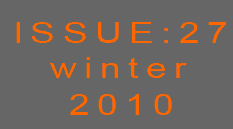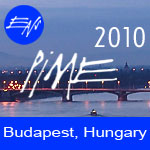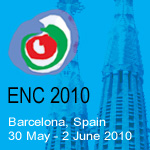 |
 |
ENS NEWS N° 27:2010: carrying the burden of great expectationsWinter appears reluctant to loosen its icy grip and for many of us life seems to be suspended in a temporary time warp. However, appearances can be deceiving. Among the many characteristics that typify the human condition is an instinctive almost genetically pre-programmed need to start again and innovate. It may be winter outside, but human endeavour is not regulated by the seasons. Underneath the layer of snow there is a hive of activity going on; a buzz of optimism and expectancy. We have left behind the “noughties” and entered the “teenies.” The first year of the new decade looks like being one marked by new departures and initiatives, by democratic consolidation and by significant political developments. 2010 promises to be a productive year on all fronts. And spring hasn’t kicked in yet! From a political perspective it certainly is all change and regeneration as a new European Commission, a new R&D Commissioner and a recently-elected European Parliament have emerged into the light of a new expectant decade. But it’s not just about changing faces; among other things, 2010 should see the adoption of a new EU Directive on radioactive waste, the launching of the European Sustainable Nuclear Industrial Initiative (ESNII) within the framework of the Strategic Energy Technology Plan (SET-Plan) and the publication of the SNETP’s Deployment Strategy document. These could prove to be significant developments for the European nuclear research community. In Europe’s corridors of power, as well as in industry circles and the media, there is recurrent talk of extending the operational duration of nuclear plants, of ambitious new build plans and of nuclear energy’s contribution to the global low-carbon economy. Gradually more countries are announcing plans for storing the radioactive waste they produce – proving that technical solutions for storing it not only exist, but are increasingly being put into practice. As fence-sitters return to ground level, and doubters doubt their doubts, public opinion continues to evolve favourably. From a research perspective the growing endorsement by Europe’s power broker’s of the need to invest more in nuclear as a pillar of the EU’s low-carbon economy is a welcome development. It is also a prerequisite. But this current momentum needs to be maintained and inspiring rhetoric turned into deeds. Research cannot prosper in a power vacuum. Politicians come and go, as do EU Framework Programmes too. But the classic polemic about where the money most needs to be spent and whether less should go to fusion and more to fission remains….as persistent and unresolved as ever. Generally speaking, however, the early signs in 2010 are positive. The announcement of new collaborative ventures aimed at pooling resources and expertise and exploiting synergies have got the new decade off to a positive start. One example of this is the new collaborative venture signed by SCK-CEN and Belgoprocess in Belgium. This strategic agreement encompasses various areas of research into nuclear technologies, with a main focus on feasibility studies, technology transfer and training. As far as ENS is concerned, the momentum of renewal is very real too: Vladimir Slugen was recently elected as new President of the Society, taking over from David Bonser. ENS NEWS N° 27 includes his first Word from the President contribution. From an industry perspective FORATOM will celebrate its fiftieth birthday this year - half a century of serving the European nuclear industry by acting as its voice and advocate in the European institutional arena. For FORATOM the political agenda promises to make 2010 a very busy year. In fact, it might even be a watershed year. But first, a word of caution….as a wise man once said (well, actually it was Linus from the cartoon series Peanuts): “There’s no heavier burden than a great potential.” Hopefully the expectations of a new nuclear decade will be matched by real progress for the research community. Hopefully the promise of success will not prove to be too heavy a burden. Only time will tell. The first ENS NEWS of the new decade kicks off with the first Word from the President penned by our new President: Vladimir Slugen outlines his priorities and vision for the future of the Society. Andrew Teller then attempts to “exorcise fears and rectify misunderstandings” that the public has when it comes to radiation. A thorough expert analysis by the High Scientific Council of ENS on the crucial subject of nuclear education, training and knowledge management in Europe then completes the ENS NEWS section. The events section of N° 27 highlights the busy ENS conference agenda in 21010, which will see three major events, PIME 2010 (Budapest, 14 – 16 February), RRFM 2010 (Marrakech, 21 – 25 March) and ENS 2010 (Barcelona, 30 May – 2 June. We have a packed Members Societies and Corporate Members section in store for you in the 2010 winter edition. First up is a report from the Bulgarian Nuclear Society on the Nuclear Power for the People conference that took place at Veliko Turnovo from 11 – 14 November 2009. That is followed by a fascinating article on the true climate change credentials of nuclear energy that was recently written by SFEN and published in the French daily newspaper, Libération. Our friends from the Nuclear Industry Association (NIA) in the UK then give readers a detailed overview of the state-of-the-art National Nuclear Laboratory facilities at Sellafield. Slovenia’s decision to locate its first low and intermediate-level waste storage site at Vrbina – close to the country’s only NPP at Krško – has been making the headlines and ENS NEWS next gives readers an insight into the selection process, the significance of the decision and the stakeholder consultation process that was a feature of it. Next up is a round up of news from the Spanish and Finnish nuclear societies: the former includes a focus on three issues of the Spanish Nuclear Society’s magazine, Nuclear España and the latter highlights, among other things, a fascinating fact-finding trip that the Finnish Nuclear Society made to South Korea. The positive evaluation that the OECD/NEA has given to the MYHRRA project is one of two detailed reports involving SCK-CEN – the other concerns the cooperation agreement that it recently signed with Belgoprocess. The YGN section of ENS NEWS N° 27 includes three reports: one on the 2009 ETRAP conference (Lisbon, 8 – 12 November, 2009), which once again put the spotlight on the importance of education and training for the future of the nuclear sector; a second one on the COP 15 global climate change conference and an event they organised with the help of WNA/FORATOM and the OECD/NEA and one from the Spanish Young Generation’s (JJNN) fact-finding visit to Chernobyl. The ENS World News section provides the usual combination of important news reports from NucNet and additional information about upcoming ENS conferences. Enjoy your latest edition of ENS NEWS!
|
||
|
||
The unending debate on radiation“Radiation is about a thousand times less hazardous than is suggested by current safety standards. For many this will come as a surprise… The case for a complete change in attitude towards radiation safety is unrelated to the effects of climate change. |
||
The medical isotope crisisLast year saw a major worldwide crisis in the availability of medical radioisotopes. More specifically in the production of Mo-99/Tc-99m generators for diagnostic nuclear medicine. We will shortly analyse the causes of the shortage and point to necessary long-term measures to avoid future crisis. |
||
Pime 201014 - 17 February 2010 in Budapest, HungaryREGISTER NOW FOR PIME 2010!ENS
PIME 2010, which will take place in
|
||
Register now for RRFM 2010!RRFM 2010 will take place from
21 – 25 March 2010 in
Marrakech.
Top-expertise and knowledge from first-class scientists and industry representatives will inspire and inform the auditory and open up new perspectives in research reactor topics. Colourful and diversified evening events at traditional places of Marrakech and a post-conference visit to the TRIGA Mark II reactor at the Maamora Nuclear Research Centre offer the perfect balance to the ambitious technical sessions. |
||
ENC 201030 May - 3 June 2010 in Barcelona, SpainENC 2010 – Programme out soon!ENS would like to thank all its members for sending contributions to ENC 2010. We received a great number of high quality abstracts which allowed the ENC Programme Committee to build a very interesting conference programme. This programme will be available from Wednesday 3 February on the ENS website and the ENC 2010 conference website. |



